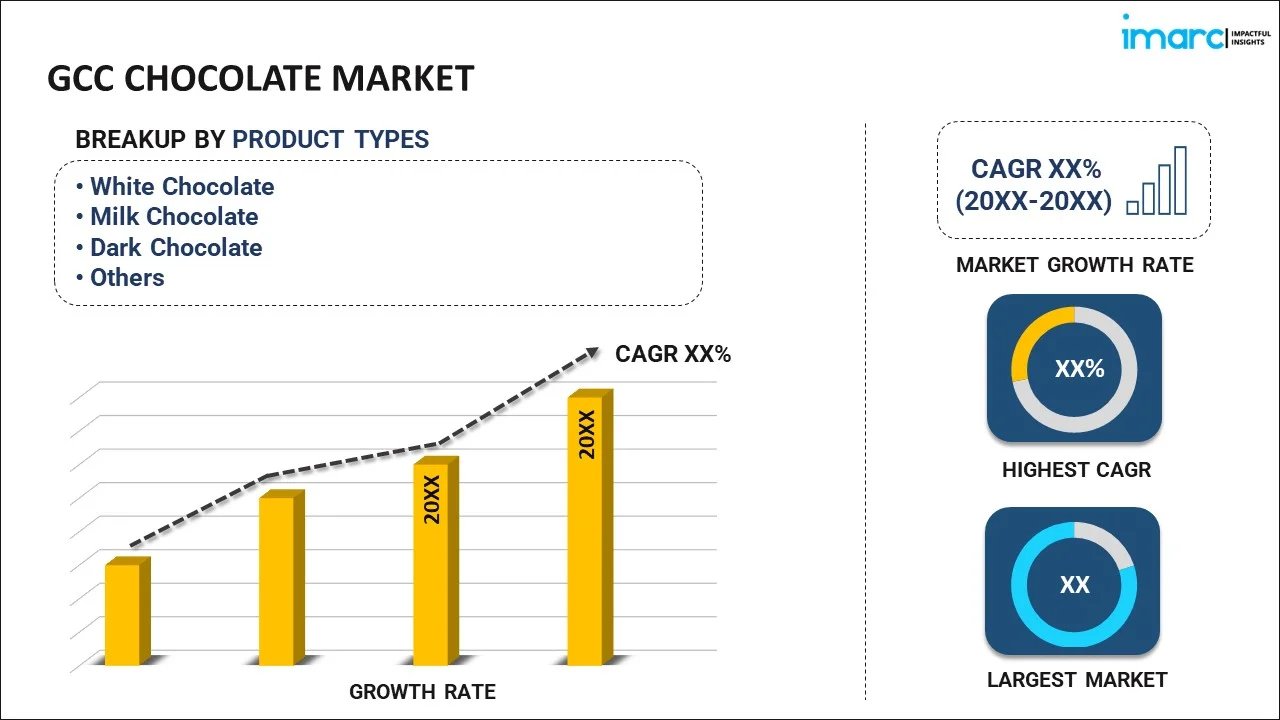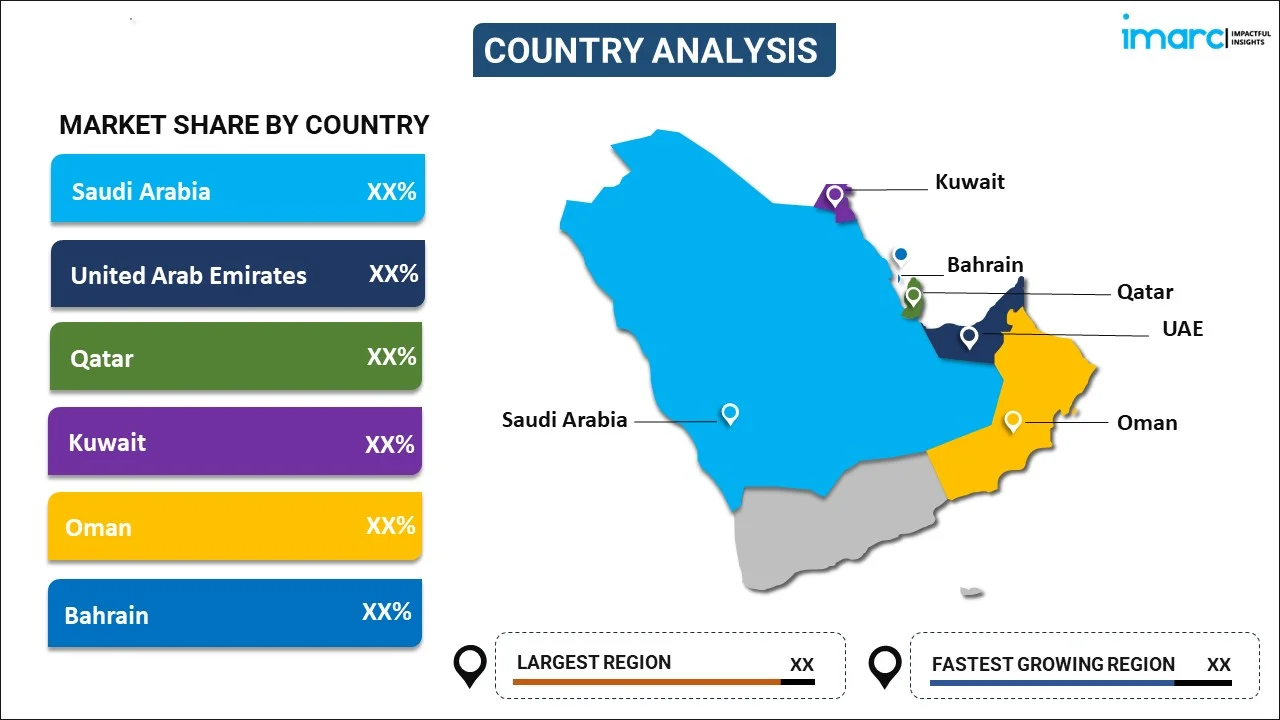
GCC Chocolate Market Report by Product Type (White Chocolate, Milk Chocolate, Dark Chocolate, and Others), Product Form (Molded, Countlines, and Others), Application (Food Products, Beverages, and Others), Pricing (Everyday Chocolate, Premium Chocolate, Seasonal Chocolate), Distribution (Direct Sales (B2B), Supermarkets and Hypermarkets, Convenience Stores, Online Stores, and Others), and Country 2025-2033
Market Overview:
The GCC chocolate market size is projected to exhibit a growth rate (CAGR) of 5.3% during 2025-2033. The increasing consumption of chocolate products that align with consumer’s wellness goals, the region's cultural celebrations and gift-giving traditions and increasing disposable incomes and a growing penchant for premium goods represent some of the key factors driving the market.
|
Report Attribute
|
Key Statistics
|
|---|---|
|
Base Year
|
2024
|
|
Forecast Years
|
2025-2033
|
|
Historical Years
|
2019-2024
|
| Market Growth Rate 2025-2033 | 5.3% |
Chocolate is a beloved treat enjoyed by populations of all ages and holds a significant place in the culinary landscape. Its rich and indulgent flavor, combined with its versatility in various culinary creations, has made it a staple ingredient. From luscious desserts to luxurious gifts, chocolate has carved its niche in both everyday life and special occasions. Its journey from cacao bean to delightful confection involves intricate processes that contribute to its distinctive taste and texture. Once harvested, cacao beans are fermented and dried to develop their complex flavors. These beans are then roasted, a critical step that brings out the beans' characteristic aromas and deepens their flavors. After roasting, the beans are cracked and the cacao nibs inside are ground into a paste called chocolate liquor. This paste contains both cacao solids and cacao butter. To create different types of chocolate, manufacturers manipulate the proportions of cacao solids and cacao butter in the chocolate liquor. Dark chocolate, known for its intense flavor and minimal sugar content, contains a higher percentage of cacao solids. Milk chocolate, on the other hand, includes milk solids and a higher proportion of sugar, giving it a creamier and sweeter profile. White chocolate, although not technically a true chocolate as it lacks cacao solids, is prepared from cacao butter, sugar, and milk solids, delivering a sweet and buttery taste. The process of refining chocolate liquor can involve conching, where the chocolate is continuously mixed and aerated for hours to enhance its smoothness and develop its flavor profile.
GCC Chocolate Market Trends:
The GCC chocolate market is primarily driven by increasing disposable incomes and a growing penchant for premium goods. The flourishing hospitality sector, which emphasizes luxurious experiences, has incorporated chocolate as an integral part of its offerings, ranging from artisanal desserts to bespoke cocoa-infused beverages. This symbiotic relationship between the chocolate industry and the hospitality sector has propelled the market forward. Moreover, changing lifestyles and preferences have led to a shift in consumer behavior. Health-conscious consumers are now seeking chocolate products that align with their wellness goals, sparking a rise in demand for dark chocolate and products with reduced sugar content. This trend has prompted chocolatiers in the GCC region to innovate and craft chocolate options that cater to these evolving tastes, further expanding the market's horizons. The GCC chocolate market is also being influenced by the region's cultural celebrations and gift-giving traditions. Chocolate, often presented as an emblem of generosity and affection, has become a popular choice for gifting during festive occasions and special moments. Chocolates, exquisitely packaged and personalized, have become a preferred gesture to convey goodwill and strengthen social bonds. This cultural significance has not only heightened chocolate consumption but has also transformed it into an integral part of the region's social fabric.
GCC Chocolate Market Segmentation:
IMARC Group provides an analysis of the key trends in each segment of the GCC chocolate market report, along with forecasts at the regional and country levels for 2025-2033. Our report has categorized the market based on product type, product form, application, pricing, and distribution.
Product Type Insights:

- White Chocolate
- Milk Chocolate
- Dark Chocolate
- Others
A detailed breakup and analysis of the market based on the product type has also been provided in the report. This includes white chocolate, milk chocolate, dark chocolate, and others.
Product Form Insights:
- Molded
- Countlines
- Others
The report has provided a detailed breakup and analysis of the market based on the product form. This includes molded, countlines, and others.
Application Insights:
- Food Products
- Bakery Products
- Sugar Confectionery
- Desserts
- Others
- Beverages
- Others
The report has provided a detailed breakup and analysis of the market based on the application. This includes food products (bakery products, sugar confectionery, desserts and others), beverages and others.
Pricing Insights:
- Everyday Chocolate
- Premium Chocolate
- Seasonal Chocolate
The report has provided a detailed breakup and analysis of the market based on the pricing. This includes everyday chocolate, premium chocolate, and seasonal chocolate.
Distribution Insights:
- Direct Sales (B2B)
- Supermarkets and Hypermarkets
- Convenience Stores
- Online Stores
- Others
The report has provided a detailed breakup and analysis of the market based on the distribution. This includes direct sales (B2B), supermarkets and hypermarkets, convenience stores, online stores, and others.
Country Insights:

- Saudi Arabia
- UAE
- Qatar
- Bahrain
- Kuwait
- Oman
The report has also provided a comprehensive analysis of all the major regional markets, which include Saudi Arabia, UAE, Qatar, Bahrain, Kuwait, and Oman.
Competitive Landscape:
The report has also provided a comprehensive analysis of the competitive landscape in the market. Competitive analysis such as market structure, key player positioning, top winning strategies, competitive dashboard, and company evaluation quadrant has been covered in the report. Also, detailed profiles of all major companies have been provided.
GCC Chocolate Market Report Coverage:
| Report Features | Details |
|---|---|
| Base Year of the Analysis | 2024 |
| Historical Period | 2019-2024 |
| Forecast Period | 2025-2033 |
| Units | Million USD |
| Scope of the Report | Exploration of Historical and Forecast Trends, Industry Catalysts and Challenges, Segment-Wise Historical and Predictive Market Assessment:
|
| Product Types Covered | White Chocolate, Milk Chocolate, Dark Chocolate, Others |
| Product Forms Covered | Molded, Countlines, Others |
| Applications Covered | • Food Products: Bakery Products, Sugar Confectionery, Desserts, Others • Beverages • Others |
| Pricings Covered | Everyday Chocolate, Premium Chocolate, Seasonal Chocolate |
| Distributions Covered | Direct Sales (B2B), Supermarkets and Hypermarkets, Convenience Stores, Online Stores, Others |
| Countries Covered | Saudi Arabia, UAE, Qatar, Bahrain, Kuwait, Oman |
| Customization Scope | 10% Free Customization |
| Post-Sale Analyst Support | 10-12 Weeks |
| Delivery Format | PDF and Excel through Email (We can also provide the editable version of the report in PPT/Word format on special request) |
Key Questions Answered in This Report:
- How has the GCC chocolate market performed so far and how will it perform in the coming years?
- What has been the impact of COVID-19 on the GCC chocolate market?
- What is the breakup of the GCC chocolate market on the basis of product type?
- What is the breakup of the GCC chocolate market on the basis of product form?
- What is the breakup of the GCC chocolate market on the basis of application?
- What is the breakup of the GCC chocolate market on the basis of pricing?
- What is the breakup of the GCC chocolate market on the basis of distribution?
- What are the various stages in the value chain of the GCC chocolate market?
- What are the key driving factors and challenges in the GCC chocolate market?
- What is the structure of the GCC chocolate market and who are the key players?
- What is the degree of competition in the GCC chocolate market?
Key Benefits for Stakeholders:
- IMARC’s report offers a comprehensive quantitative analysis of various market segments, historical and current market trends, market forecasts, and dynamics of the GCC chocolate market from 2019-2033.
- The research study provides the latest information on the market drivers, challenges, and opportunities in the GCC chocolate market.
- Porter's five forces analysis assist stakeholders in assessing the impact of new entrants, competitive rivalry, supplier power, buyer power, and the threat of substitution. It helps stakeholders to analyze the level of competition within the GCC chocolate industry and its attractiveness.
- Competitive landscape allows stakeholders to understand their competitive environment and provides an insight into the current positions of key players in the market.
Need more help?
- Speak to our experienced analysts for insights on the current market scenarios.
- Include additional segments and countries to customize the report as per your requirement.
- Gain an unparalleled competitive advantage in your domain by understanding how to utilize the report and positively impacting your operations and revenue.
- For further assistance, please connect with our analysts.
 Request Customization
Request Customization
 Speak to an Analyst
Speak to an Analyst
 Request Brochure
Request Brochure
 Inquire Before Buying
Inquire Before Buying




.webp)




.webp)












